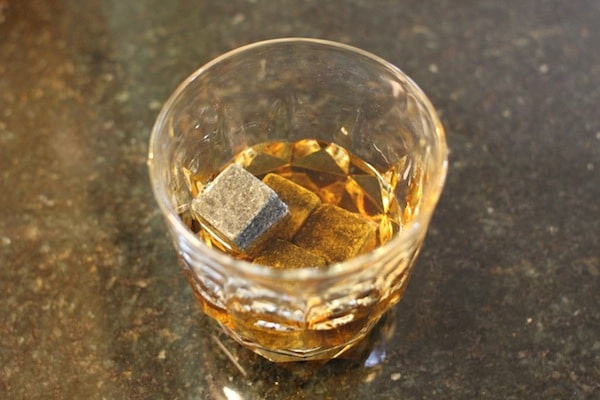Summer’s blistering temperatures often spur the craving for a refreshing, ice cold beverage. Whether enjoying whiskey or soda, most people want some chill before drinking. How do you go about it, though? The most common method is obviously ice — but what kind of ice is best? Crushed? Cubed? With whiskey, many drinkers don’t want to dilute the drink, and so opt-out of ice altogether in favor of cooling down their spirit with whiskey stones (usually made of soapstone).
It may seem like a simple choice, but the size of the cube actually determines a lot in regards to temperature and how long the drink will stay cold. So which of these methods is the best? What’s the optimal size for ice cubes? No need to experiment for yourselves — we’ve done the legwork for you. Below are the results of my experiment — be cool and read on.
Methodology

I used whiskey for this particular experiment (Russell’s Reserve 10-Year Bourbon, to be exact). Whiskey is stored at room temperature, and while many people don’t chill it, most do. While I used a uniform beverage for this article, I also tested soda (just ice, though, not the stones/balls), and the results were fairly similar. If you’re throwing back some Virgil’s Root Beer, this information is still helpful.
I measured the starting temperature, which in this case was 70 degrees — room temp. I then used 5 different cooling methods, measuring the immediate temperature, then measuring again every half hour for two hours.

The ice ball, whiskey stones, and stainless whiskey balls.
The cooling methods I used:[amazon asin=B00H8RVMC8&template=*lrc ad (right)]
- Whiskey stones (made of soapstone)
- Whiskey balls (a stainless steel whiskey “stone”)
- Ice ball (just a single giant ice cube)
- Ice cubes (from a standard refrigerator ice maker or ice tray)
- Crushed ice
I hypothesized that the more surface area a cube had, the faster it would cool the drink, but also the more quickly it would melt. Let’s see if the data bore this theory out.
Whiskey Stones

The whiskey stone was first created in the mid-2000s by a company called Teroforma. They quickly caught on with whiskey enthusiasts who wanted to chill but not dilute their drink, and whiskey stones have since been[amazon asin=B007ACTN54&template=*lrc ad (right)] replicated by a number of companies. The idea is that you store the stones in the freezer, and drop a few into your drink when you’re ready to imbibe. I had used whiskey stones before doing this experiment, however, and they hadn’t seemed very effective. Were my senses accurate? Let’s take a look at the data (all numbers are in degrees Fahrenheit):
- Starting temp: 70
- One min after stones added: 62
- After 30 min: 65
- 60 min: 66
- 90 min: 66
- 120 min: 67[amazon asin=B00F2PE17Q&template=*lrc ad (right)]
So the whiskey stones did indeed chill the drink, without diluting it. Just not by a whole lot; it was only after knowing that the temperature was 8 degrees lower that I actually noticed any change. There’s a good chance it was just my brain, but I suppose the seasoned expert would be able to notice a difference. You can see that after two hours, it was nearly back up to room temperature, which is in line with what most whiskey stone makers will claim.
The other downside is that high-proof whiskies are still a lot to handle without a little bit of dilution. Stranahan’s Whiskey, for instance (a hometown favorite of mine), is intentionally made strong so that consumers can individually dilute the drink to their tastes. Even the founder, Jess Graber, dilutes his whiskey (usually with ice).
Final Verdict: I wasn’t a huge fan of whiskey stones before the experiment, and while they do more than I expected, I’m still not a fan, and probably won’t use them a whole lot.
Whiskey Balls

Balls of Steel makes a stainless steel whiskey chiller, setting it apart from the classic soapstone whiskey stone. They have some kind of proprietary chilling technology, and are also lighter in weight than whiskey stones, which they tout as one of their selling points. As with stones, you store them in the freezer until needed, and then pop them in your drink. The disclaimer is that you’re supposed to remove the balls before drinking, but since it’s a [amazon asin=B005D78RPU&template=*lrc ad (right)]sipping beverage, you aren’t likely to accidentally swallow them, and it’s a bit annoying to have to fish them out. Does the steel work any better than the soapstone?
- Starting temp: 70
- One min after balls added: 60
- After 30 min: 60
- 60 min: 64
- 90 min: 65
- 120 min: 65
You can see that the Balls of Steel initially cooled the beverage a little better than the stones. It also held its cool temperature better, but only for the first hour or so. That’s generally enough to finish a drink or two, though, so that’s not much of an issue.
Final Verdict: If you’re going to go with a non-diluting whiskey-chilling product, steel balls are your best choice. They cool a little better and a little longer than soapstone. As a bonus, the company gives 15% of its profits to testicular cancer awareness and research.




